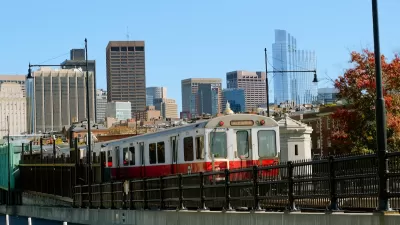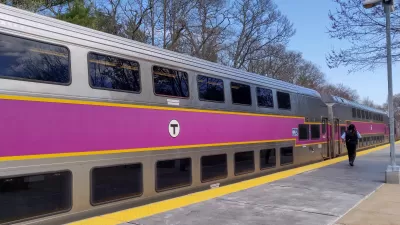The ‘T’ is reworking its schedule to offer more reliable and flexible service, including more midday and weekend trains.

Boston’s commuter rail system has recovered as much as 96 percent of pre-pandemic ridership, reports Daniel C. Vock in Route Fifty, far outpacing most commuter rail agencies around the country.
“There are a lot of factors at play, but one that sets Boston apart is the extent to which it has reworked its service to better serve people traveling in the middle of the day, in the evening and on weekends.” Boston’s success validates the growing movement to readjust transit schedules and routes to better serve post-pandemic transportation needs. In many cases, these needs were already there, borne by largely ignored groups such as transit-dependent working women with children.
The Massachusetts Bay Transportation Authority (MBTA) owns 12 commuter rail lines that span almost 400 miles. “Significantly, it owns most of those tracks, while many other commuter rail agencies have to use tracks owned by freight railroads for all or most of their routes.”
According to the MBTA, “The goal is to get trains on a clock-face schedule, so people know what time their trains will leave—say, 10 minutes past the hour—without having to look it up.” The agency is also adding more trips, particularly during midday and nights and weekends.
FULL STORY: Boston-area commuter rail bounces back, while other agencies lag

Alabama: Trump Terminates Settlements for Black Communities Harmed By Raw Sewage
Trump deemed the landmark civil rights agreement “illegal DEI and environmental justice policy.”

Planetizen Federal Action Tracker
A weekly monitor of how Trump’s orders and actions are impacting planners and planning in America.

The 120 Year Old Tiny Home Villages That Sheltered San Francisco’s Earthquake Refugees
More than a century ago, San Francisco mobilized to house thousands of residents displaced by the 1906 earthquake. Could their strategy offer a model for the present?

In Both Crashes and Crime, Public Transportation is Far Safer than Driving
Contrary to popular assumptions, public transportation has far lower crash and crime rates than automobile travel. For safer communities, improve and encourage transit travel.

Report: Zoning Reforms Should Complement Nashville’s Ambitious Transit Plan
Without reform, restrictive zoning codes will limit the impact of the city’s planned transit expansion and could exclude some of the residents who depend on transit the most.

Judge Orders Release of Frozen IRA, IIJA Funding
The decision is a victory for environmental groups who charged that freezing funds for critical infrastructure and disaster response programs caused “real and irreparable harm” to communities.
Urban Design for Planners 1: Software Tools
This six-course series explores essential urban design concepts using open source software and equips planners with the tools they need to participate fully in the urban design process.
Planning for Universal Design
Learn the tools for implementing Universal Design in planning regulations.
Clanton & Associates, Inc.
Jessamine County Fiscal Court
Institute for Housing and Urban Development Studies (IHS)
City of Grandview
Harvard GSD Executive Education
Toledo-Lucas County Plan Commissions
Salt Lake City
NYU Wagner Graduate School of Public Service





























